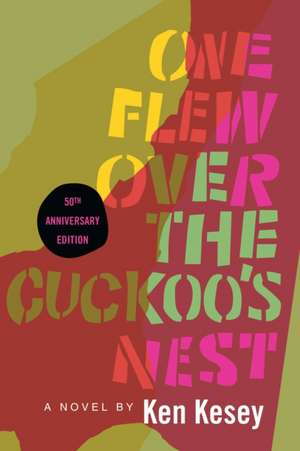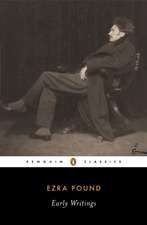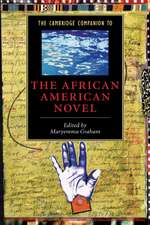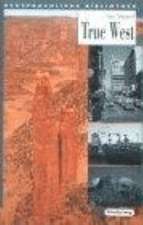One Flew Over the Cuckoo's Nest
Autor Ken Keseyen Limba Engleză Hardback – 31 dec 2011 – vârsta de la 18 ani
A fiftieth-anniversary edition of Ken Kesey's searing American classic.
Boisterous, ribald, and ultimately shattering, Ken Kesey's One Flew Over the Cuckoo's Nest has left an indelible mark on the literature of our time. Turning conventional notions of sanity and insanity on their heads, the novel tells the unforgettable story of a mental ward and its inhabitants, especially tyrannical Big Nurse Ratched and Randle Patrick McMurphy, the brawling, fun-loving new inmate who resolves to oppose her. We see the story through the eyes of Chief Bromden, the seemingly mute half-Indian patient who witnesses and understands McMurphy's heroic attempt to do battle with the powers that keep them all imprisoned.
Hailed upon its publication as "a glittering parable of good and evil" (The New York Times Book Review) and "a roar of protest against middlebrow society's Rules and the invisible Rulers who enforce them" (Time), Kesey's powerful book went on to sell millions of copies and remains as bracing and insightful today as when it was first released. This new deluxe hardcover edition commemorates the fiftieth anniversary of the original publication of the novel on February 1, 1962, and will be a must have for any literature lover.
Boisterous, ribald, and ultimately shattering, Ken Kesey's One Flew Over the Cuckoo's Nest has left an indelible mark on the literature of our time. Turning conventional notions of sanity and insanity on their heads, the novel tells the unforgettable story of a mental ward and its inhabitants, especially tyrannical Big Nurse Ratched and Randle Patrick McMurphy, the brawling, fun-loving new inmate who resolves to oppose her. We see the story through the eyes of Chief Bromden, the seemingly mute half-Indian patient who witnesses and understands McMurphy's heroic attempt to do battle with the powers that keep them all imprisoned.
Hailed upon its publication as "a glittering parable of good and evil" (The New York Times Book Review) and "a roar of protest against middlebrow society's Rules and the invisible Rulers who enforce them" (Time), Kesey's powerful book went on to sell millions of copies and remains as bracing and insightful today as when it was first released. This new deluxe hardcover edition commemorates the fiftieth anniversary of the original publication of the novel on February 1, 1962, and will be a must have for any literature lover.
| Toate formatele și edițiile | Preț | Express |
|---|---|---|
| Paperback (6) | 53.66 lei 26-32 zile | +19.89 lei 7-13 zile |
| Penguin Books – 4 mai 2005 | 53.66 lei 26-32 zile | +19.89 lei 7-13 zile |
| Signet Book – 31 ian 1963 | 60.23 lei 3-5 săpt. | +10.13 lei 7-13 zile |
| Penguin Books – 25 iun 2008 | 70.26 lei 26-32 zile | +26.72 lei 7-13 zile |
| Penguin Books – 30 noi 2002 | 95.29 lei 3-5 săpt. | |
| Penguin Books – 18 oct 2016 | 97.74 lei 3-5 săpt. | +16.45 lei 7-13 zile |
| Penguin Books – 31 dec 1995 | 190.40 lei 3-5 săpt. | |
| Hardback (1) | 175.99 lei 3-5 săpt. | |
| Viking Books – 31 dec 2011 | 175.99 lei 3-5 săpt. |
Preț: 175.99 lei
Nou
Puncte Express: 264
Preț estimativ în valută:
33.67€ • 35.25$ • 27.86£
33.67€ • 35.25$ • 27.86£
Carte disponibilă
Livrare economică 15-29 martie
Preluare comenzi: 021 569.72.76
Specificații
ISBN-13: 9780670023233
ISBN-10: 067002323X
Pagini: 277
Dimensiuni: 157 x 229 x 25 mm
Greutate: 0.5 kg
Ediția:Anniversary
Editura: Viking Books
ISBN-10: 067002323X
Pagini: 277
Dimensiuni: 157 x 229 x 25 mm
Greutate: 0.5 kg
Ediția:Anniversary
Editura: Viking Books
Notă biografică
Ken Kesey was born in 1935 and grew up in Oregon. He graduated from the University of Oregon and later studied at Stanford with Wallace Stegner, Malcolm Cowley, Richard Scowcroft, and Frank O' Connor. One Flew Over the Cuckoo's Nest, his first novel, was published in 1962. His second novel, Sometimes a Great Notion, followed in 1964. His other books include Kesey's Garage Sale, Demon Box, Caverns (with O. U. Levon), The Further Inquiry, Sailor Song, and Last Go Round (with Ken Babbs). His two children's books are Little Tricker the Squirrel Meets Big Double the Bear and The Sea Lion. Ken Kesey died on November 10, 2001.
Robert Faggen teaches at Claremont McKenna College.
Robert Faggen teaches at Claremont McKenna College.
Descriere
A world classic by Kesey (1935-2001) that has been considered one of the greatest works of literature in the 20th century. This new deluxe hardcover edition commemorates the 50th anniversary of the original publication of the novel on February 1, 1962, and is a must-have for any literature lover.
Cuprins
One Flew Over the Cuckoo's Nest Introduction
Chronology
I. One Flew Over the Cuckoo's Nest: The Text
II. The Author and His Work
TOM WOLFE, What Do You Think of My Buddha?
KEN KESEY, An Early Draft of the Opening Scene of One Flew Over the Cuckoo's Nest
KEN KESEY, Letter to Ken Babbs: ["Peyote and Point of View"]
KEN KESEY, Letter to Ken Babbs: ["People on the Ward"]
KEN KESEY, Characters on the Ward
KEN KESEY, Draft Page with Holograph Revisions
KEN KESEY, from An Impolite Interview with Ken Kesey
KEN KESEY, from Ken Kesey Was a Successful Dope Fiend
KEN KESEY, Who Flew Over What?
III. Literary Criticism
JACK F. MCCOMB, The RPM
LESLIE A. FIEDLER, The Higher Sentimentality
TERRY G. SHERWOOD, One Flew Over the Cuckoo's Nest and the Comic Strip
JAMES E. MILLER, JR., The Humor in the Horror
JOSEPH J. WALDMEIR, Two Novelists of the Absurd: Heller and Kesey
JOHN A. BARSNESS, Ken Kesey: The Hero in Modern Dress
IRVING MALIN, Ken Kesey: One Flew Over the Cuckoo's Nest
ROBERT BOYERS, Porno-Politics
HAROLD CLURMAN, Review of the Play
WALTER KERR, ...And the Young Flew Over the Cuckoo's Nest
MARCIA L. FALK, Letter to the Editor of The New York Times
LESLIE HORST, Bitches, Twitches, and Eunuchs: Sex-Role Failure and Caricature
ANNETTE BENERT, The Voices of Fear: Kesey's Anatomy of Insanity
BENJAMIN GOLUBOFF, The Carnival Artist in the Cuckoo's Nest
MARSHA MCCREADIE, One Flew Over the Cuckoo's Nest: Some Reasons for One Happy Adaptation
CAROL PEARSON, The Cowboy Saint and the Indian Poet: The Comic Hero in Ken Kesey's One Flew Over the Cuckoo's Nest
IV. Analogies and Perspectives
DALE WASSERMAN, from his play One Flew Over the Cuckoo's Nest
MARY FRANCES ROBINSON, Ph.D., and WALTER FREEMAN, M.D., Ph.D., F.A.C.P., Glimpses of Postlobotomy Personalities
ARTHUR P. NOYES, M.D., and LAWRENCE C. KOLB, M.D., Shock and Other Physical Therapies
RALPH ELLISON, from Invisible Man
ROBERT PENN WARREN, from All the King's Men
KEN KESEY, Neal Cassady
JACK KEROUAC, from On the Road
Topics for Discussion and Papers
Selected Bibliography prepared by Joseph Weixlmann and M. Gilbert Porter
Chronology
I. One Flew Over the Cuckoo's Nest: The Text
II. The Author and His Work
TOM WOLFE, What Do You Think of My Buddha?
KEN KESEY, An Early Draft of the Opening Scene of One Flew Over the Cuckoo's Nest
KEN KESEY, Letter to Ken Babbs: ["Peyote and Point of View"]
KEN KESEY, Letter to Ken Babbs: ["People on the Ward"]
KEN KESEY, Characters on the Ward
KEN KESEY, Draft Page with Holograph Revisions
KEN KESEY, from An Impolite Interview with Ken Kesey
KEN KESEY, from Ken Kesey Was a Successful Dope Fiend
KEN KESEY, Who Flew Over What?
III. Literary Criticism
JACK F. MCCOMB, The RPM
LESLIE A. FIEDLER, The Higher Sentimentality
TERRY G. SHERWOOD, One Flew Over the Cuckoo's Nest and the Comic Strip
JAMES E. MILLER, JR., The Humor in the Horror
JOSEPH J. WALDMEIR, Two Novelists of the Absurd: Heller and Kesey
JOHN A. BARSNESS, Ken Kesey: The Hero in Modern Dress
IRVING MALIN, Ken Kesey: One Flew Over the Cuckoo's Nest
ROBERT BOYERS, Porno-Politics
HAROLD CLURMAN, Review of the Play
WALTER KERR, ...And the Young Flew Over the Cuckoo's Nest
MARCIA L. FALK, Letter to the Editor of The New York Times
LESLIE HORST, Bitches, Twitches, and Eunuchs: Sex-Role Failure and Caricature
ANNETTE BENERT, The Voices of Fear: Kesey's Anatomy of Insanity
BENJAMIN GOLUBOFF, The Carnival Artist in the Cuckoo's Nest
MARSHA MCCREADIE, One Flew Over the Cuckoo's Nest: Some Reasons for One Happy Adaptation
CAROL PEARSON, The Cowboy Saint and the Indian Poet: The Comic Hero in Ken Kesey's One Flew Over the Cuckoo's Nest
IV. Analogies and Perspectives
DALE WASSERMAN, from his play One Flew Over the Cuckoo's Nest
MARY FRANCES ROBINSON, Ph.D., and WALTER FREEMAN, M.D., Ph.D., F.A.C.P., Glimpses of Postlobotomy Personalities
ARTHUR P. NOYES, M.D., and LAWRENCE C. KOLB, M.D., Shock and Other Physical Therapies
RALPH ELLISON, from Invisible Man
ROBERT PENN WARREN, from All the King's Men
KEN KESEY, Neal Cassady
JACK KEROUAC, from On the Road
Topics for Discussion and Papers
Selected Bibliography prepared by Joseph Weixlmann and M. Gilbert Porter
Recenzii
"A glittering parable of good and evil." —The New York Times Book Review
"A roar of protest against middlebrow society’s Rules and the Rulers who enforce them." —Time
"A roar of protest against middlebrow society’s Rules and the Rulers who enforce them." —Time
Extras
Sketches
Psychedelic sixties. God knows whatever that means it certainly meant far more than drugs, though drugs still work as a pretty good handle to the phenomena.
I grabbed at that handle. Legally, too, I might add. Almost patriotically, in fact. Early psychedelic sixties...
Eight o'clock every Tuesday morning I showed up at the vet's hospital in Menlo Park, ready to roll. The doctor deposited me in a little room on his ward, dealt me a couple of pills or a shot or a little glass of bitter juice, then locked the door. He checked back every forty minutes to see if I was still alive, took some tests, asked some questions, left again. The rest of the time I spent studying the inside of my forehead, or looking out the little window in the door. It was six inches wide and eight inches high, and it had heavy chicken wire inside the glass.
You get your visions through whatever gate you're granted.
Patients straggled by in the hall outside, their faces all ghastly confessions. Sometimes I looked at them and sometimes they looked at me. but rarely did we look at one another. It was too naked and painful. More was revealed in a human face than a human being can bear, face-to-face.
Sometimes the nurse came by and checked on me. Her face was different. It was painful business, but not naked. This was not a person you could allow yourself to be naked in front of.
Six months or so later I had finished the drug experiments and applied for a job. I was taken on as a nurse's aide, in the same ward, with the same doctor, under the same nurse—and you must understand we're talking about a huge hospital here! It was weird.
But, as I said, it was the sixties.
Those faces were still there, still painfully naked. To ward them off my case I very prudently took to carrying around a little notebook, to scribble notes. I got a lot of compliments from nurses: "Good for you, Mr. Kesey. That's the spirit. Get to know these men."
I also scribbled faces. No, that's not correct. As I prowl through this stack of sketches I can see that these faces bored their way behind my forehead and scribbled themselves. I just held the pen and waited for the magic to happen.
This was, after all, the sixties.
Ken Kesey
Psychedelic sixties. God knows whatever that means it certainly meant far more than drugs, though drugs still work as a pretty good handle to the phenomena.
I grabbed at that handle. Legally, too, I might add. Almost patriotically, in fact. Early psychedelic sixties...
Eight o'clock every Tuesday morning I showed up at the vet's hospital in Menlo Park, ready to roll. The doctor deposited me in a little room on his ward, dealt me a couple of pills or a shot or a little glass of bitter juice, then locked the door. He checked back every forty minutes to see if I was still alive, took some tests, asked some questions, left again. The rest of the time I spent studying the inside of my forehead, or looking out the little window in the door. It was six inches wide and eight inches high, and it had heavy chicken wire inside the glass.
You get your visions through whatever gate you're granted.
Patients straggled by in the hall outside, their faces all ghastly confessions. Sometimes I looked at them and sometimes they looked at me. but rarely did we look at one another. It was too naked and painful. More was revealed in a human face than a human being can bear, face-to-face.
Sometimes the nurse came by and checked on me. Her face was different. It was painful business, but not naked. This was not a person you could allow yourself to be naked in front of.
Six months or so later I had finished the drug experiments and applied for a job. I was taken on as a nurse's aide, in the same ward, with the same doctor, under the same nurse—and you must understand we're talking about a huge hospital here! It was weird.
But, as I said, it was the sixties.
Those faces were still there, still painfully naked. To ward them off my case I very prudently took to carrying around a little notebook, to scribble notes. I got a lot of compliments from nurses: "Good for you, Mr. Kesey. That's the spirit. Get to know these men."
I also scribbled faces. No, that's not correct. As I prowl through this stack of sketches I can see that these faces bored their way behind my forehead and scribbled themselves. I just held the pen and waited for the magic to happen.
This was, after all, the sixties.
Ken Kesey



















